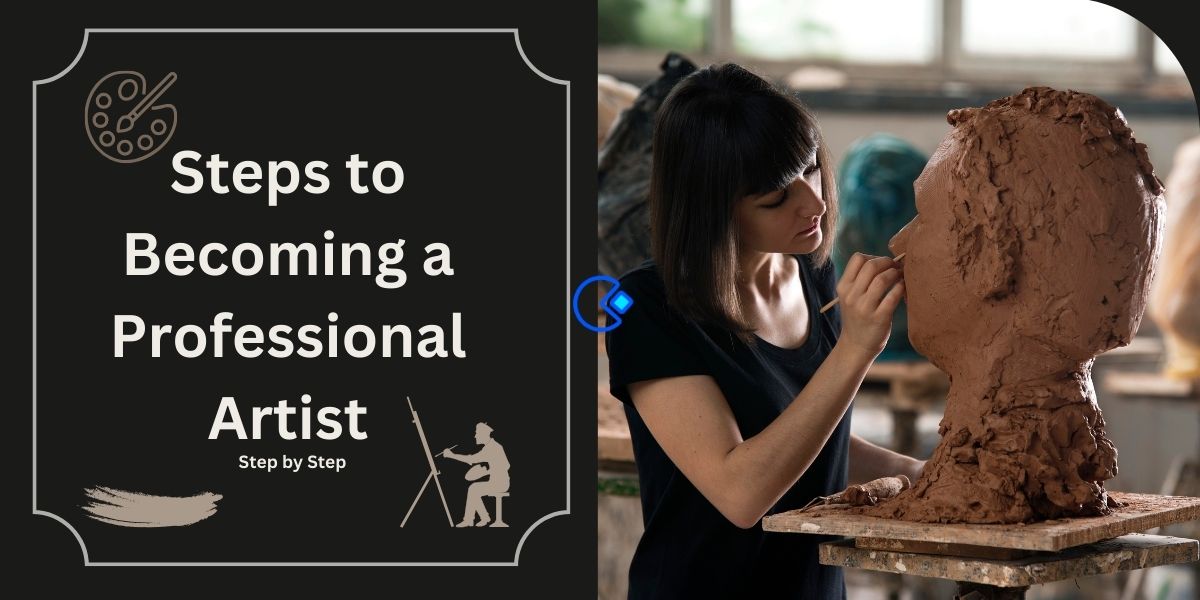The journey to becoming a professional artist is a transformative pursuit that requires good strategy. Transitioning from an amateur artist to a professional artist, an artist who earns money for their work, can be challenging.
Developing your talent and exhibiting your work will help you establish yourself as a professional artist so that you can begin to earn a living.
The competitive art landscape demands a tailored approach, and our 10-step guide is precisely what you need to navigate this exciting path.
An Overview of Being an Artist
Being an artist is a broad term that describes anyone with the talent to conceptualize and produce creative works.
You can refer to the countless creativity-based professions as artists, including:
- Painters who use different mediums like watercolors, pencils, oil colors on canvas, acrylic colors, etc.
- Sculptors
- Illustrators
- Digital artists
- Illustrators
- Graphic designers (might also include web designers)
- Jewelry designers
- Crafters that specialize in crocheting, embroidery, wood carving, pottery, and the like
What does a fine artist do?
A fine artist creates original artwork using one or more forms of art. They may use painting, sculpture, drawing, printing, or digital media.
Some fine artists focus on a single subject or style, while others create art with a variety of subjects or styles. Fine artists may show and sell their art in galleries, work with art dealers, or work with art patrons.
They may also commission works for private collectors, corporations, or governments. Ad agencies, corporate marketing departments, and media companies may purchase fine artists for digital media.
Additionally, some fine artists may work as part of a creative team or staff within a company. Here are six examples of things that fine artists regularly do while working:
- Preparing to create: This often involves brainstorming ideas and producing sketches, drafts, and prototypes.
- Obtaining and prepping materials: Sourcing and prepping materials like canvasses, paints, and clays for artistic works is important to the overall aesthetic outcome of an artistic project.
- Developing a portfolio: This involves gathering a body of artistic works for a portfolio. It can also include taking high-resolution photographs of artistic creations.
- Making business connections: This process revolves around interacting with potential gallery partners or clients.
- Relationship building and networking: Building and solidifying relationships with art dealers, brokers, and gallery owners is crucial to developing your professional reputation, defining your personal brand, and building a network.
- Communicating with clients: When communicating with clients, artists listen to their project goals or personal desires and discuss the ways they might meet those expectations. It also involves negotiating the sale and commission of artistic works.
10 Steps to Becoming a Professional Artist
Here are 10 steps to take to develop your career and become a professional artist:
1. Hone Your Skills
The first and most important step in becoming a professional artist is to develop your skills. Build up your knowledge and brush-handling capabilities by taking classes, studying expert work, and practicing. If you want to be a professional, you need to get your work to a level where it can hold its own among all the other artists.
Artists must always be learning new skills and refining their existing skills so as to remain on the cutting edge of artistic innovation.
Additionally, experimenting with new art forms and new mediums may lead to inspiration or the discovery of new talents or passions. It may also lead to new connections within the industry, which can be crucial to your career development.
2. Earn a bachelor’s degree
A bachelor’s degree in fine arts from a recognized college or university provides a firm foundation in fundamental artistic abilities like sketching, painting, and materials management.
You’ll most likely study art history, art appreciation, and digital arts as an undergraduate.
Attending a fine arts or related undergraduate program might help you broaden your skill set and knowledge base.
It may also provide you with access to skilled teachers and artists, as well as assist you in developing a network of peers and colleagues for future collaborations or business engagements.
3. Complete an internship
If you’re looking for a great way to get hands-on training and learn new skills, internships are the way to go. Plus, you’ll get to experience working with galleries, collectors, buyers, and artists.
It’s a great way to make connections in the art industry and the local art scene.
Check with your professor, advisor, or student services coordinator if you’re interested in applying for an internship during your last two years of college. You can also check out job search sites, gallery websites, or art journals for more information.
4. Create art and take photographs
If you want to become a fine artist, it’s important to create and experiment with your art. Not only will this help you learn and grow, but it’ll also help you build a reputation and a following. To do this, you’ll need to take high-quality photos of your work.
Make sure there’s no blur, use a tripod, and the lighting is even. Experts suggest taking the photos outside on a nice, sunny day with a white box. Midday is also a great time to take the photos, so aim to shoot between 11 a.m. and 2 p.m.
Your main image should only show the painting and nothing else; you can just crop it out with photo manipulation software if you’re selling digital art.
5. Connect with other artists
Reaching out and connecting with other artists is very beneficial for further developing your artistic abilities and expanding your professional network. Try connecting with others using social media or joining professional groups.
You can also try joining or forming a collective creative space to share ideas and techniques. These groups are helpful for gaining access to other artist’s network connections, and they can be a fantastic means of advancing as a professional artist.
6. Consider earning an MFA
Earning a Master’s in Fine Art (MFA) provides students with advanced skills and training to enhance their portfolios and professional reputations as artists. Here are five positive outcomes that can come from earning an MFA:
- Access to well-studied artists and professors of art: Access to high-level educators with specialties in unique, or advanced, art forms
- Intensive artistic training: developing and sustaining an effective studio practice that is disciplined, consistent, and conducive to thriving as a professional artist
- Extensive knowledge of craft: By engaging in an MFA program, you can increase your knowledge of different techniques and artistic concepts. It can also give you access to materials, techniques, and tools to develop your craft and professional artistry.
- Exposure to art history: deepening and expanding awareness of art history, which includes influential artists, important artistic techniques, and artistic movements
- In-depth study of influential artists: exposure to the lineage of artists and artistic expressions that are crucial for enhancing appreciation and personal passion for artistic work
7. Decide what type of art inspires you
Deciding the type of art that inspires you is critical to creating focus and direction in your effort toward becoming a professional artist.
Think about both artistic styles and techniques that intrigue you, and seek out opportunities to view or experiment with different art forms.
It’s important to remember that this decision can help you focus, and it can direct you to the specific skills or materials you need to develop those skills. It may even help you create connections within your target audience.
However, it is not a final decision. Being a fine artist is a creative and imaginative career choice, and one of the core benefits of this career is the freedom of expression.
So, if your inspiration changes over time, it’s perfectly natural to allow your art and creations to change and adapt as well.
8. Create two portfolios
Creating both a physical and digital portfolio are crucial tools for finding work—and finding success—in today’s artistic environment.
Your physical portfolio should house examples of your drawings, paintings, or other types of works, while your digital portfolio will be an online link to your comprehensive collection of completed works.
Creating a strong digital portfolio with high-quality digital renderings of your work is important for showcasing your talent as an artist as well as your ability to market that talent as a professional.
Including a link to your digital portfolio on your resume or social media page can help you make connections, and it may even help you find work.
9. Create a resume
Crafting an eye-catching and persuasive resume that clearly displays your artistic education, background, and experience is an important step on the path to becoming a fine artist.
Emphasizing specific artistic skills acquired, degrees obtained, and your most impressive achievements are all important for creating a powerful resume.
Providing links to your portfolio of works in your resume can give hiring managers and recruiters a more comprehensive understanding of who you are as an artist and professional.
10. Apply for an entry-level position
Apply for an entry-level position at a place that is relevant to your career goals as a fine artist. It’s a constructive way to gain knowledge, experience, and connections.
Working in places such as galleries, art supply stores, museums, and studios is a great way to broaden your knowledge and demonstrate your commitment to your career goals.
Why Should You Consider Becoming an Artist?
While making a good profit as an artist requires a lot of hard work and time, there are many reasons make this career path worth taking.
- Full of opportunities: You can be an artist by specializing in one of numerous areas, many of which may not have much competition yet. Besides digital art or painting, other creative pieces like NFTs can also be sold at high prices.
- Easy to promote: Nowadays, marketing your products or art pieces on the internet couldn’t be easier. You can target specific audiences who might take a liking to your style through social media, SEO marketing, email marketing, etc.
- You set your work hours: It’s time to say goodbye to working a fixed number of hours every day. By becoming a freelance artist, your schedule will be flexible,grantingt you a more laid-back lifestyle!
- You have power over your rates: While you still have to keep the market’s rates in mind, only you can determine the value of your work. Even better, handmade crafts already sell at higher prices than mass-produced items.
How much do artists make?
It’s possible to earn money as a side hustle by making art, even if you don’t have an art degree.
Because of the wide variety of career options for an artist, you can expect that the monthly income of artists differs according to many variables.
Such factors may include whether or not these individuals have a degree, if they’re working full-time vs. freelance, their location, etc.
How Long Does It Take to Become a Professional Artist?
The time it takes to make money as an artist depends on several factors; the most important one is your current skill level.
If you’re a pro, you can build your portfolio immediately, set up your online shop, and price your products.
In that case, all your artwork needs is to find interested customers through virtual shops and then get sold. This process can take a month or two to several months, depending on how popular your art gets.
Otherwise, starting art classes and working on your skills will require more time, from six months to a year, depending on your progress.
In this scenario, you can expect to start making money by selling your art online within a year and a half or two years.
How do I earn a living as a professional artist?
Here are steps to take to earn a living as a professional artist:
1. Research the market to price your art.
To determine how much to charge for your art, assess the size, shape, medium, weight, subject matter, colors, how long it took you to make it, how much the supplies cost, and how experienced you are in that particular artistic medium.
Once you have determined these factors, research how much similar pieces in your area tend to sell for. You can do this by searching online or by talking to stores, galleries, and other retailers that sell similar artwork.
When you price your art, you need to be able to justify the amount. While your artwork is surely unique, so is every piece of original art.
Thus, this cannot be a major factor in determining how much you should charge for your pieces. When you first start selling your art, you may have to sell it for less than what other, established artists are selling their work for. After selling a few pieces, you can begin charging more.
2. Create a business plan
Regardless of what type of art you create, writing a business plan can help you establish your goals as a professional artist and determine your financial needs. As part of your business plan, research and outline the potential markets for your type of art.
Take into consideration all the ways that you can potentially sell your art, as well as the prices you have determined for the various types of pieces you create.
Then, outline in your business plan how many pieces you need to produce and sell to meet your financial needs and how you are going to go about doing so.
In determining your financial needs, consider all the things that you need to pay for, including food, housing, more art supplies, and any other expenses you incur on a daily, weekly, monthly, or yearly basis.
3. Join professional art organizations
Search online to find professional organizations that are relevant to your type of artwork and sign up to become a member.
This can help you establish yourself as a professional artist and send the message to potential clients and/or employers that you take your career as an artist seriously.
In addition, professional organizations can provide opportunities for you to network with other artists, helping you spread the word about your work.
Joining organizations and staying connected to local artistic communities is a great way to meet other artists, learn about the industry, and get exposure.
4 Sell your work in stores, galleries, or online.
In addition to promoting your work, you can also sell it in a store or gallery. While retail stores and galleries take a percentage of your sales, selling your art through such companies is a great way to expose your work to a larger audience. And hopefully, we will make more sales.
In addition to brick-and-mortar options, look into the many ways to sell your art online, including through social media, an artist collective website, or your own retail website.
Learning how to sell your art on Etsy is also a great option. Etsy is a popular site that gets a lot of traffic, so it is a great way to expose your work to a large audience and help you make a living as a professional artist.
5. Create commission pieces
If you’re showing your art anywhere, make sure to let people know that you can also make custom pieces for individual customers on commission.
A lot of artists do this at some point, and while it’s not as steady or as fulfilling as following their own ideas, it can still help you get your work out there and make some money.
The key to successful commission work is to be open to hearing what your clients have to say. You want to be true to yourself, but you’re also getting paid to make something special for your clients.
Finding the right balance between your own wants and needs can make the experience more beneficial, help you build your reputation, and get more commission work.
6. Teach art workshops and classes.
As a professional artist, you can make money while sharing your knowledge and skills by teaching classes and/or workshops to budding artists.
There are several opportunities you can look into, including teaching classes at a studio, gallery, community center, or school.
Teaching can also help you stay up to date on current trends and techniques, helping you improve your own skills. You might even find that you learn some new ideas or find new inspiration from your students!
7. Produce art for a company as an employee.
Work as an in-house artist for a company in need of your artistic skills. There are many companies that hire professional artists and art directors including software and print material companies, advertising and design agencies, and motion picture companies.
These types of companies are consistently in need of artists with various special skills, including graphic design, product label design, and illustration.
Working as a professional artist for a company has the added benefit of ensuring that you have a steady salary.
Conclusion
Being a professional is more than just meeting certain goals. It’s also how you present yourself. It’s how you carry yourself, the way you dress, and the confidence you show in your work.
When you engage in the art world, dress well, look clean, present your work in the best light, and have professional-looking marketing materials.
There are many paths to becoming a professional artist because every artist (and every person) is unique. But you can use this information as a general template to help you get going in the right direction and discover your individual track.




 Jobi.ng
Jobi.ng




